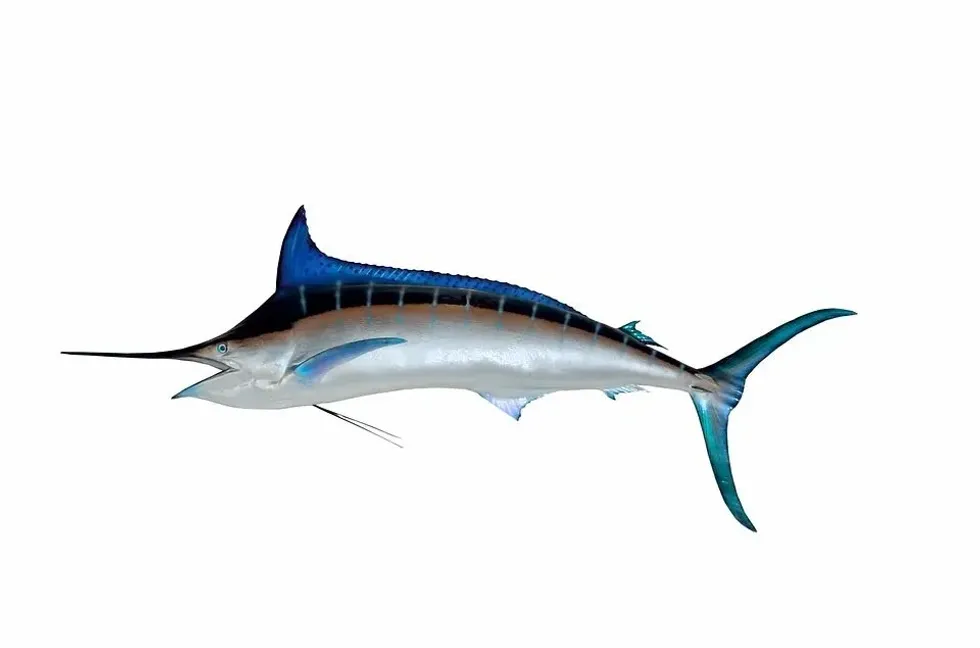In this article, we will talk and learn about the lives of the blue marlin (scientific name Makaira nigricans). This marlin has been one of the prized catches of recreational hunters since the 1920s in the Bahamas.
This sport caught on to the point that today the Atlantic blue marlin is recognized as the national fish of the Bahamas.
Spread over the Atlantic and the Pacific Oceans, their range is extensive and extends to 45 degrees North in the western North Pacific, about 35 degrees North in the eastern North Pacific, 35 degrees South in the western South Pacific, and about 25 degrees South in the Eastern South Pacific.
This magnificent marlin preys on many species near the surface.
They use their long distinct bill to stun their prey. Despite being adept predators, they are still not at the top of the ocean food chain and end up being prey to predators like killer whales, sharks, and shortfin makos.
It is humans, though, that pose the most serious risk to these fish by overhunting and polluting their habitat.
The blue marlin, because of these reasons, is listed as Vulnerable by the IUCN. So, read on for more info on this fish.
If you are interested in reading more about the marlin species, check out billfish and marlins.
Blue Marlin Interesting Facts
What type of animal is a blue marlin?
The blue marlin is a type of fish.
What class of animal does a blue marlin belong to?
A blue marlin belongs to the class Actinopterygii and the family Istiophoriformes.
How many blue marlins are there in the world?
Since the geographical range of the blue marlins is extensive, there have been no studies conducted to calculate the total population of blue marlins in the world.
Where does a blue marlin live?
The blue marlin can be found living in the deep blue, tropical, and temperate waters of the Pacific, Atlantic, and Indian Oceans.
What is a blue marlin's habitat?
The blue marlin lives in blue oceanic waters. They swim long distances and follow warm ocean currents and migrate seasonally to stay in warm waters near the surface.
Who does blue marlin live with?
The blue marlins live a solitary life from birth and are rarely found hunting in schools. They spend the majority of their lifespan in the open sea and follow warm currents.
How long does a blue marlin live?
The marlin species have a relatively long lifespan. The females outlive the males and have a life expectancy of 27 years, whereas the males have a life expectancy of 18 years.
How do they reproduce?
The marlins attain sexual maturity between the ages of two and four. The spawning usually occurs between July to October in the North Atlantic.
In the Pacific Ocean, however, the spawning season lasts from December to January. Blue marlins reproduce through external fertilization.
During spawning, the females lay close to several million eggs and release them into the water column, where the male blue marlin releases his sperm. The spherical eggs are 0.039 in (0.99 mm) in diameter and are transparent, yellow, or white. The eggs are buoyant and float until the fry hatch, without any parental care.
Larvae can be found in the Bahamas, Florida, Jamaica, Puerto Rico, and the Atlantic Ocean off the coast of Georgia. The marlins grow very fast, and the larvae grow about 0.63 in (16 mm) every single day.
What is their conservation status?
The blue marlin's (Makaira nigricans) population has been decreasing and they have been listed as Vulnerable on the International Union for Conservation of Nature's Red List of Endangered Species. Scientists have found that expanding ocean dead zones are resulting in habitat loss for fish like marlins and tunas.
Commercial fishing has also been a cause of worry for the declining population of the species.
Blue Marlin Fun Facts
What does the blue marlin look like?

Bright cobalt blue-black on top and silver-white on the underside, the marlin species is truly majestic. They have a distinct, sharp spear-shaped upper jaw.
Their stout bill is long and pointed, and they have two elongated pelvic fins and dorsal fins. The first of the two dorsal fins is dark blue or black, and all the other fins are dark brown. Their large body is covered with bony scales.
How cute are they?
The striking marlin, blue in color, is one of the biggest fish in the world. Their spear-shaped, lethal upper jaw makes them quite frightening to look at, and they do not appear to be either cute or adorable.
How do they communicate?
Blue marlins communicate with each other using chemical releases.
How big is a blue marlin?
Blue marlins are one of the largest among their species and have an average length of 11 ft. The female blue marlins are larger than males and have a length of about 16 ft. However, a blue whale is almost six times larger than a blue marlin.
How fast can a blue marlin swim?
Blue marlins are among the fastest creatures in the ocean and can reach speeds of up to 68 mph.
How much does a blue marlin weigh?
Marlins are among the largest in the ocean. The highest recorded weight for the Atlantic blue marlin is 1,803 lb. The Pacific blue marlin can weigh up to 2,000 lb. The female marlins grow larger than the males.
What are the male and female names of the species?
There are no unique names to identify the male and female blue marlins.
What would you call a baby blue marlin?
A baby marlin can be referred to as a fry.
What do they eat?
The marlin species go from being microscopic at birth to becoming one of the largest in the ocean finally, and their diet has a big role to play in this development. Adult marlins are one of the largest predators and eat a wide range of fish like tuna, squid, and mackerel.
The marlin larvae' diet includes fish eggs, other larvae, and a wide variety of zooplankton.
The marlin uses its sharp spear-like bill to slash through the schools of its prey and later come back to consume it. Their list of prey includes the large white marlin as well as small fish like yellowfin and tuna.
Are they poisonous?
Marlins have been found to contain large traces of mercury, which can prove to be harmful to humans, but these fish are not poisonous and can be consumed.
Would they make a good pet?
No, blue marlins cannot be kept as pets. This fast and strong bony fish is among the largest in the ocean and cannot be kept in one place due to its size as well as its highly migratory nature.
Did you know...
Commercial fishing is one of the major threats to blue marlins. This marine fish is high in demand, especially in Japan, where its tasty meat is served raw as sashimi.
There are two schools of thought when it comes to deciding whether Atlantic blue marlins and Pacific blue marlins belong to the same species or not.
Females can lay as many as 3o million eggs a year.
Similar to other billfish, this marlin has light-reflecting cells and pigments on its body which allow it to change color.
Marlins are a highly migratory species and can cross entire ocean basins by following warm currents like the Gulf Stream in the western Atlantic. One blue marlin was tagged in the Western Atlantic Ocean and later found in the Indian Ocean.
Scientists have debated with fishermen about the usage of the marlin's spear-shaped upper jaw in feeding.
Marlins have been featured in articles by Ernest Hemingway and Zane Grey, where they talk about their fishing experience. It has also been featured in Hemingway's book, 'The Old Man And The Sea'.
In the game 'Animal Crossing: New Horizon', you can buy a blue marlin for 10,000 bells!
What is the difference between a blue marlin and a swordfish?
The marlin and the swordfish are some of the biggest fish in the ocean world. The pointed, spear-like bill of both the blue marlin and swordfish can make it quite confusing to distinguish between the two.
One way to differentiate is to observe their dorsal fin.
The dorsal fin of the swordfish resembles a shark and extends even further, whereas the blue marlin has a single dorsal fin which creates a soft-looking ridge. The swordfish also has long, distinct, pectoral fins as opposed to the marlin, whose pectoral fins are not visible.
Does blue marlin have teeth?
Yes, blue marlins do have teeth. Their teeth are small and are lined on the roof of their mouth and jaws.
Here at Kidadl, we have carefully created lots of interesting family-friendly animal facts for everyone to discover! Learn more about some other fish including the rainbow cichlid and the angelfish.
You can even occupy yourself at home by coloring in one of our free printable blue marlin coloring pages.










